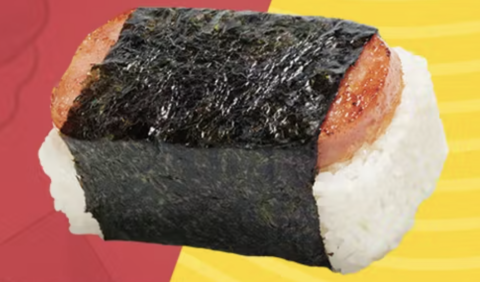Monday August 8 is the Second Annual L&L Hawaiʻi National Spam Musubi Day, and that means a free musubi from L&L Hawaiʻi. Launched by the venerable Hawaiʻi company and licensed by Hormel Foods, this it-should-be-a-holiday is another quirky and fun Hawaiʻi thing.
And because I love both spam and history, letʻs have a little of both in todayʻs blog post. 
Spam musubi is sticky white rice topped with a slice of seasoned cooked spam, wrapped up in a piece of crunchy nori seaweed. In my post on 12 Things Native Hawaiian and Hawaiʻi Kids Like, — my addition to children’s author Tara Lazar’s 500+ Things That Kids Like — spam musubi is right there near the top of the list. Thatʻs because itʻs a convenient, inexpensive, packable lunch.
Canned spam first became popular in Hawaiʻi during WW II. Soon home cooks were creating dishes made from the salty canned meat. When I was growing up, we ate spam all the time, including fried with eggs and rice (which is a favorite breakfast order at Hawaiʻi McDonalds restaurants.) The first time my college roommates saw me frying up spam, they freaked out, that is, until they tasted it.
Hawaiʻiʻs Barbara Funamura is credited with inventing spam musubi in the early 1980s for the Joni-Hana restaurant on Kauaiʻi, according to the Garden Island newspaper. Mrs. Funamura had no idea that her humble recipe would, like many great inventions, become so popular.
My kids grew up packing spam musubis to eat after hula and soccer practice, and to this day, itʻs a satisfying treat. Our simple method was simply splashing a bit of shoyu into the pan as the spam cooked, but a search on the internet reveals lots of fancy recipes.
Oh, and did you get the August 8/8–08 shout-out to our area code? Happy Spam Musubi day! Photo credit: L&L Hawaiian BBQ





 July 31 is Lā Hoʻi Hoʻi ʻEa in Hawaiʻi! Established by Kauikeauoli (King Kamehameha III), Sovereignty Restoration Day is a national holiday that commemorates the return in 1843 of Hawaiʻi to the rightful Hawaiian government after it was seized by the United Kingdom. He declared, “Ua mau ke ʻea o ka ʻāina i ka pono,” the life of the land is perpetuated in righteousness. E mau a mau!
July 31 is Lā Hoʻi Hoʻi ʻEa in Hawaiʻi! Established by Kauikeauoli (King Kamehameha III), Sovereignty Restoration Day is a national holiday that commemorates the return in 1843 of Hawaiʻi to the rightful Hawaiian government after it was seized by the United Kingdom. He declared, “Ua mau ke ʻea o ka ʻāina i ka pono,” the life of the land is perpetuated in righteousness. E mau a mau!